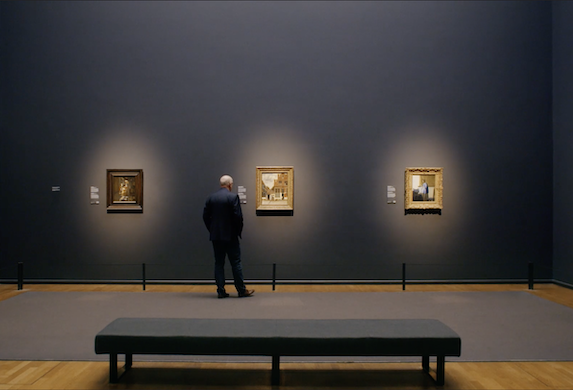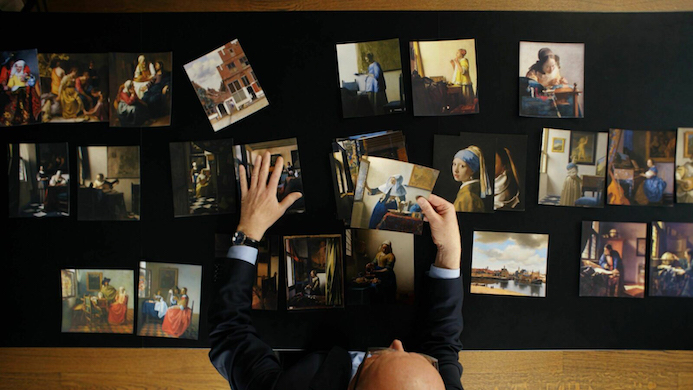Little Is Known About Vermeer, but the Guy Is a Rock Star
That his achievement was unheralded for almost 200 years after his death can be hard to square given his fame now. A new film details the preparations leading up to the current retrospective of his paintings.

Where were you during the great Vermeer kerfuffle of 2022? It centered on “Girl With a Flute” (c. 1669-75), a staple of the collection of the National Gallery of Art at Washington, D.C., and an attribution that has long been held in question. Is the painting by a revered Dutch master, Johannes Vermeer (1632-75), or, as the museum states, the work of “Studio of Johannes Vermeer?”
Anyone who has stood in front of the diminutive picture — it barely measures seven by eight inches — can’t help but be entranced by it. Those porcelain highlights, the subtle transitions of unlikely colors, and that distinctive admixture of expectation and intimacy — surely this is the work of the same painter who gave us “Woman with a Water Jug,” “The Art of Painting,” and something called “Girl With a Pearl Earring”?
The head of the Department of Fine Arts at Amsterdam’s Rijksmuseum, Gregor J.M. Weber, along with the museum’s head of paintings and sculpture, Peter Roelofs, are convinced that it’s the real deal. Mr. Weber, who’s been around the block and then some with 17th-century Dutch painting, can’t conceive of another figure capable of such painterly sonorities. The creator of the “Essential Vermeer” website and a veteran painter, Jonathan Janson, is on board with Messrs. Weber and Roelofs.
Betsy Weiseman and Alexandra Libby, curators at the National Gallery, along with Research Conservator Melanie Gifford, think otherwise. Pointing to stylistic and material quirks in the picture, they’ve come to the conclusion that “Girl With a Flute” is by a hand nowhere near as nuanced or expert as Vermeer’s. Erring on the side of connoisseurship and science, the officials at Washington come to a not unreasonable conclusion. Still, the world needs all the Vermeers it can get, as do Messrs. Weber and Roelofs. Surely, a little fudging is in order?
A polite butting of heads between the two Dutchmen and their American counterparts provides a tense third act to “Close to Vermeer,” the new documentary by Suzanne Raes. The film details the preparations leading up to the current retrospective of paintings by the artist famously dubbed the Sphinx of Delft by the 19th-century art critic Théophile Thoré-Bürger. That Vermeer’s achievement was unheralded for almost 200 years after his death can be hard to square given his current fame. Little is known about him: He had 10 children, was a convert to Catholicism, was debt-ridden, and was dead by age 43. Who taught Vermeer? We don’t know.
“Vermeer” is an exhibition unlikely to occur again, corralling, as it does, 28 of the 37 known paintings by the artist. The show, which closes on June 4, has been sold out for some time. Close to half a million tickets were snapped up in record time: Johannes, my man, is a rock star.
New Yorkers can count themselves lucky: between the Met and the Frick Collection, there are eight Vermeers within a mile of each other. Rope in the four pictures at the National Gallery — let’s include “Girl With A Flute,” shall we? — and American collections can claim an impressive third of the elusive painter’s oeuvre.

“Close to Vermeer” details the efforts on behalf of Messrs. Weber and Roelofs to secure loans for the show. The erstwhile curators have their hearts broken along the way. The Met refuses to loan “Young Woman with a Water Pitcher” (c. 1662) and “Study of a Young Woman” (c. 1665-67). The Herzog Anton Ulrich-Museum at Brunswick, Germany, turns down the request to lend “The Girl with a Wine Glass” (c. 1659-60). That painting will be the focus of a writing project on behalf of the schoolchildren of Brunswick. The curators, on behalf of the community, come down firmly on the side of the local.
“Girl With a Flute” isn’t the only painting with attribution problems. Much hoop-jumping is undergone in proving whether “A Young Woman Seated at the Virginal” (c. 1670) is genuine. We watch as the American financier Thomas Kaplan allows the jewel in his collection to undergo a battery of tests to determine its authenticity. The picture is eye-balled, picked at, pondered and, in the end, given a stamp of approval by — well, most of the experts. Mr. Weber has his doubts, as do I. Audiences who watch this splendid, measured, and often moving film can make up their own minds.

